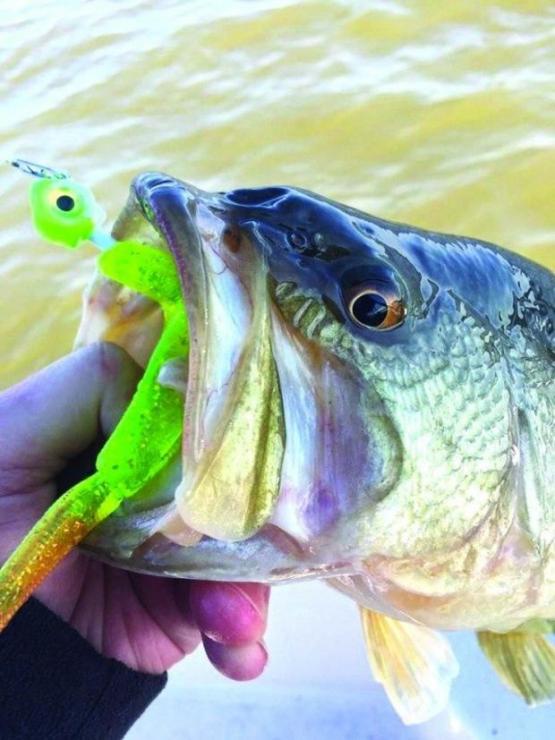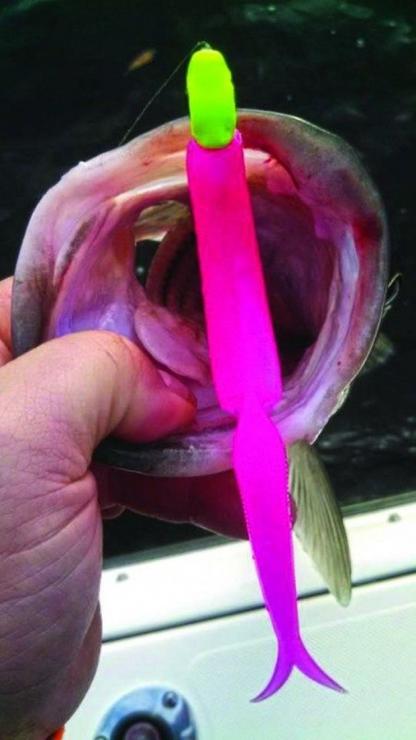 Bust 'Em Baits and G-Eye Jigs
Bust 'Em Baits and G-Eye Jigs
Time was the only way to catch big fall run rockfish was either with live eels or trolling, both of which typically used gear that was on the heavy side. While both of these techniques still work today, improvements in gear—specifically super strong, thin, braided line and hi-tech materials to make stronger, lighter rods and reels—have been incredible game-changers for light tackle anglers.
For the uninitiated, LTJ, as it’s commonly known on the Chesapeake, may be described as a style of fishing using a lead jighead (3/0 to 6/0 hook; 1/2-4 ounces) paired with a soft plastic lure designed to be similar in profile to a real baitfish. The combo is dropped on a school of suspended or breaking gamefish, and the lure is retrieved through the water column in a jerky, sweeping motion, interrupted by short pauses so the bait flutters back down. Often, the strike comes on the lure’s descent.
The popularity of this style of fishing has also spawned scores of regional and local rod and lure makers whose products are tailor-made for striper fishing in the Chesapeake in coming months.
“We started this company (in 2010) to make custom colors for customers who were looking for that color no one else had,” says Branden Wallace, one of the three Bust ‘Em Baits founders, along with partners CJ Espey and Bill Wallace. They use liquid plastisol in a hand-injected process to make their custom soft baits. The liquid is heated, then solidifies and becomes clear. Once it reaches a certain temperature and is free of air bubbles, they then add the dyes and glitters. The Baltimore-based company hand-inspects each bait prior to packaging to guarantee there are no flaws.
Since Bust ‘Em Baits only made the plastic lures, they teamed up with Lonnie Johnson, creator of G-Eye Jigs based in Chesapeake Beach, MD.

“It turns out that Lonnie is on the same game plan as we are. I can honestly say that Bust ‘Em Baits and G-Eye Jigs are on the same wavelength as far as I can see,” Branden says.
Adds Johnson, “I could never find a soft plastic bait with a forked tail that was exactly what I wanted, and I always had to compromise on color when I tried to match them with my G-Eye Jigs. The increased action from the Bust ‘Em Baits’ notched tail and the increased action from G-Eye Jig’s patent-pending design create unmatched action.”
Like the boys at Bust ‘Em Baits, Johnson too focuses on details and quality, specifically the eyes. He believes it is cruicial to the lure’s effectiveness, since gamefish often key on the eye when preparing to strike. Johnson says G-Eye Jigs are hand poured using the highest quality materials and attention to detail. For example, the prism eyes are super glued into sockets. Each jig is finished with a top coat of UV paint for increased underwater visibility, and he uses Mustard’s UltraPoint wide-gap, extra strong flipping hook to ensure that when that big striper is hooked, it stays hooked.
The best part of being local lure makers? These guys say it’s seeing someone holding up their personal best fish with a huge smile on their face, and making friends with many very good area anglers.
As the days get shorter and the water temperatures drop, why not give this local duo a shot? Taking their advice, I plan on jigging a two-toned, skirted G-Eye Jig, matched with an Albino or Dry Ice Bust ‘Em Bait. And as the fellas are quick to remind me: try not to be scared to go with some color contrast. Sometimes an oddball color combo catches when “match the bait” does not.
by Captain Chris D. Dollar Bust 'Em Baits and G-Eye Jigs
Time was the only way to catch big fall run rockfish was either with live eels or trolling, both of which typically used gear that was on the heavy side. While both of these techniques still work today, improvements in gear—specifically super strong, thin, braided line and hi-tech materials to make stronger, lighter rods and reels—have been incredible game-changers for light tackle anglers.
For the uninitiated, LTJ, as it’s commonly known on the Chesapeake, may be described as a style of fishing using a lead jighead (3/0 to 6/0 hook; 1/2-4 ounces) paired with a soft plastic lure designed to be similar in profile to a real baitfish. The combo is dropped on a school of suspended or breaking gamefish, and the lure is retrieved through the water column in a jerky, sweeping motion, interrupted by short pauses so the bait flutters back down. Often, the strike comes on the lure’s descent.
The popularity of this style of fishing has also spawned scores of regional and local rod and lure makers whose products are tailor-made for striper fishing in the Chesapeake in coming months.
“We started this company (in 2010) to make custom colors for customers who were looking for that color no one else had,” says Branden Wallace, one of the three Bust ‘Em Baits founders, along with partners CJ Espey and Bill Wallace. They use liquid plastisol in a hand-injected process to make their custom soft baits. The liquid is heated, then solidifies and becomes clear. Once it reaches a certain temperature and is free of air bubbles, they then add the dyes and glitters. The Baltimore-based company hand-inspects each bait prior to packaging to guarantee there are no flaws.
Since Bust ‘Em Baits only made the plastic lures, they teamed up with Lonnie Johnson, creator of G-Eye Jigs based in Chesapeake Beach, MD.
Bust 'Em Baits and G-Eye Jigs
Time was the only way to catch big fall run rockfish was either with live eels or trolling, both of which typically used gear that was on the heavy side. While both of these techniques still work today, improvements in gear—specifically super strong, thin, braided line and hi-tech materials to make stronger, lighter rods and reels—have been incredible game-changers for light tackle anglers.
For the uninitiated, LTJ, as it’s commonly known on the Chesapeake, may be described as a style of fishing using a lead jighead (3/0 to 6/0 hook; 1/2-4 ounces) paired with a soft plastic lure designed to be similar in profile to a real baitfish. The combo is dropped on a school of suspended or breaking gamefish, and the lure is retrieved through the water column in a jerky, sweeping motion, interrupted by short pauses so the bait flutters back down. Often, the strike comes on the lure’s descent.
The popularity of this style of fishing has also spawned scores of regional and local rod and lure makers whose products are tailor-made for striper fishing in the Chesapeake in coming months.
“We started this company (in 2010) to make custom colors for customers who were looking for that color no one else had,” says Branden Wallace, one of the three Bust ‘Em Baits founders, along with partners CJ Espey and Bill Wallace. They use liquid plastisol in a hand-injected process to make their custom soft baits. The liquid is heated, then solidifies and becomes clear. Once it reaches a certain temperature and is free of air bubbles, they then add the dyes and glitters. The Baltimore-based company hand-inspects each bait prior to packaging to guarantee there are no flaws.
Since Bust ‘Em Baits only made the plastic lures, they teamed up with Lonnie Johnson, creator of G-Eye Jigs based in Chesapeake Beach, MD.
 “It turns out that Lonnie is on the same game plan as we are. I can honestly say that Bust ‘Em Baits and G-Eye Jigs are on the same wavelength as far as I can see,” Branden says.
Adds Johnson, “I could never find a soft plastic bait with a forked tail that was exactly what I wanted, and I always had to compromise on color when I tried to match them with my G-Eye Jigs. The increased action from the Bust ‘Em Baits’ notched tail and the increased action from G-Eye Jig’s patent-pending design create unmatched action.”
Like the boys at Bust ‘Em Baits, Johnson too focuses on details and quality, specifically the eyes. He believes it is cruicial to the lure’s effectiveness, since gamefish often key on the eye when preparing to strike. Johnson says G-Eye Jigs are hand poured using the highest quality materials and attention to detail. For example, the prism eyes are super glued into sockets. Each jig is finished with a top coat of UV paint for increased underwater visibility, and he uses Mustard’s UltraPoint wide-gap, extra strong flipping hook to ensure that when that big striper is hooked, it stays hooked.
The best part of being local lure makers? These guys say it’s seeing someone holding up their personal best fish with a huge smile on their face, and making friends with many very good area anglers.
As the days get shorter and the water temperatures drop, why not give this local duo a shot? Taking their advice, I plan on jigging a two-toned, skirted G-Eye Jig, matched with an Albino or Dry Ice Bust ‘Em Bait. And as the fellas are quick to remind me: try not to be scared to go with some color contrast. Sometimes an oddball color combo catches when “match the bait” does not.
by Captain Chris D. Dollar
“It turns out that Lonnie is on the same game plan as we are. I can honestly say that Bust ‘Em Baits and G-Eye Jigs are on the same wavelength as far as I can see,” Branden says.
Adds Johnson, “I could never find a soft plastic bait with a forked tail that was exactly what I wanted, and I always had to compromise on color when I tried to match them with my G-Eye Jigs. The increased action from the Bust ‘Em Baits’ notched tail and the increased action from G-Eye Jig’s patent-pending design create unmatched action.”
Like the boys at Bust ‘Em Baits, Johnson too focuses on details and quality, specifically the eyes. He believes it is cruicial to the lure’s effectiveness, since gamefish often key on the eye when preparing to strike. Johnson says G-Eye Jigs are hand poured using the highest quality materials and attention to detail. For example, the prism eyes are super glued into sockets. Each jig is finished with a top coat of UV paint for increased underwater visibility, and he uses Mustard’s UltraPoint wide-gap, extra strong flipping hook to ensure that when that big striper is hooked, it stays hooked.
The best part of being local lure makers? These guys say it’s seeing someone holding up their personal best fish with a huge smile on their face, and making friends with many very good area anglers.
As the days get shorter and the water temperatures drop, why not give this local duo a shot? Taking their advice, I plan on jigging a two-toned, skirted G-Eye Jig, matched with an Albino or Dry Ice Bust ‘Em Bait. And as the fellas are quick to remind me: try not to be scared to go with some color contrast. Sometimes an oddball color combo catches when “match the bait” does not.
by Captain Chris D. Dollar